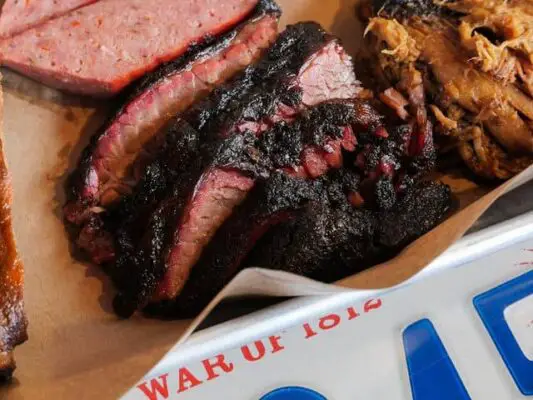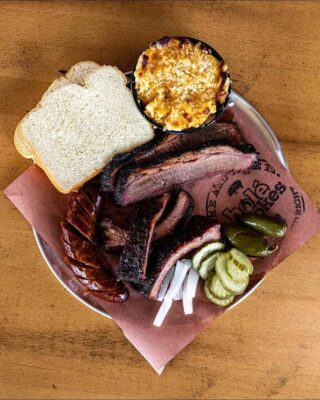Last Updated on: 8th November 2023, 06:47 pm
Bark and smoke rings are the most common ways to show your smoking skills to your guests.
But smoking is a prolonged process, and a little flaw can lead to the waste of all your efforts.
So there are several things to keep in mind while smoking a brisket.
One of the most important things is the time the brisket takes to get bark.
As a general rule, brisket can take 3–5 hours to develop a good bark.
This time can vary depending on several factors.
These factors can include stall, temperature, moisture, fat content, etc.
But given the normal smoking conditions, your brisket won’t take more than 5 hours to get smoked.
if you have smoked your brisket for more than five hours and the brisket still doesn’t have the bark, then there is something wrong.
It can occur either due to low temperature or high moisture. you should consider checking our guide on why I am not getting bark on my brisket for more information.
Development of bark consists of several phases which take some time to complete.
You need to take other factors into account before checking the development of bark.
In other words, you should not solely depend on time as a measure for deciding the completeness of bark.
Smoking for too much time results in overcooking and burning of the bark, while smoking for a shorter time results in uncooked meat.

You need to be familiar with the science behind the development of bark to decide how much time it will take for your brisket to get bark.
The development of bark consists of the following steps:
- First of all, when the rub is applied to the surface of meat, some of the rub particles are dissolved in the fat present on the surface of meat.
- After that , some of the remaining components of the rub are dissolved in the moisture present in the smoke and smoker.
rubs need to be applied at the right time to make sure you smoke brisket effectively. here is an ultimate guide to when to apply rub when smoking brisket.
These dissolved ruby components lead to the formation of glaze. The glaze reacts with the undissolved components and forms a pasty solution. - After that, when the temperature of the smoker is increased, the Maillard reaction occurs. In this reaction, proteins break down to form polymers.
These polymers react with the pasty solution present on the surface of the meat to produce a crust. - Lastly, the moisture is evaporated from the crust of the meat to produce a dry and darkened crust known as “bark”
Factors affecting the time taken for the brisket to get bark
We have discussed above that your brisket might take 3-5 hours to get bark.
But you need to be careful about the middle 2-hour range because if you make a mistake, then you might end up overcooking or undercooking your brisket.
These are the most common factors that can affect the development of bark on the brisket.
Stall: Do you wrap the brisket or not?
Stall is the most important factor that affects the time taken for the development of bark.
The way you beat the stall affects the time taken for bark development.
You can either wrap the brisket to make it stall or power through it by increasing the temperature.
For those who don’t know what a stall is, a stall is a phase of smoking in which the temperature of the brisket stops increasing.
The reason behind this is that when the temperature increases, the moisture present in the brisket evaporates and cools down the surface of the brisket.
Due to the surface cooling down, the internal temperature of the brisket stops increasing.
It usually occurs around 160°F, but the internal temperature of the brisket needs to be around 200°F to consider the brisket as completely smoked. here is a complete guide on at what temp does a brisket stall .
This phase is known as “stall”
It can occur for several hours, which can affect the time taken for the brisket to develop bark.
The reason is that you need to cook brisket evenly, so some pitmasters tend to wrap the brisket to increase the temperature.
It can beat stall, but it will affect the bark.

By wrapping, it will take less time to cook, but the brisket will not get charred when wrapped.
Its bark will be complete when you take it out of the aluminum foil after stalling.
The reason is that the bark will become moist during wrapping, so it will need more time to complete.
If you don’t wrap the brisket during the stall, then the bark will develop quicker, but the brisket will take longer to cook completely.
It is entirely up to you whether to wrap it or not, but keep in mind that it will affect the time it takes for the bark to develop.
Temperature
Temperature is another important factor that decides how much time it will take your brisket to get bark.
The temperature needs to be maintained between 225°F and 250°F for the development of bark while preventing the brisket from drying out.
Temperature is the most important factor for the development of bark on brisket. usually 225 degrees is the best temperature for the development of bark on brisket.
you should also check our article on the best temperature for the development of bark on brisket.
Higher temperatures will result in the burning and charring of the bark.
Charring is the blackening of the bark of a brisket.
It is really dangerous if eaten in excess and is often related to stomach cancer.
While cooking at a low temperature can result in undercooking of the brisket.
In addition, at lower temperatures, the bark can become soggy and moist.
So, by cooking at a low temperature, your brisket might not develop bark at all. You need to be careful about the temperature when smoking brisket.
You have to keep in mind both the bark and the internal side of the brisket while deciding the temperature.
At lower temperatures, the bark will not develop while. At higher temperatures, the brisket will remain uncooked.
Moisture
Moisture is another factor that you need to keep in mind while deciding how much time it will take for your brisket to get bark.
If the moisture is too low, the brisket will dry out, while a higher temperature will result in soggy bark.
Moisture is crucial for the development of bark because it is important for the dissolving of the rub components.
These rub components are dissolved in the moisture, then react with polymers present in the meat and result in the development of bark.
But both low and high moisture can result in affecting the development of bark.
If the moisture level is too high, then the bark will become soggy and moist.
If the moisture is too low, then the Maillard reaction will not occur properly and the bark will not develop at all.
Rub
The rub is also an important factor in deciding the time taken for the development of bark.
Bark develops by the reaction of rub with the pellicle of meat and the smoke.
If the rub is of low quality, then it will take longer to develop the bark.
Rubs with a higher sugar content are generally thought to be better for bark development.
But it is not proven yet because sugar caramelizes at 300°F but bark develops around 250°F.
In addition, you also need to be careful about the type of sugar you are using because it can result in the clumping of rum.
Moreover, the rub with some good quality spices can develop the bark quicker if apple cider vinegar is spritzed onto the meat during smoking.
The reason is that apple cider vinegar breaks down the spices and helps get a better bark.
Frequently asked questions
here are some of the most common faqs asked by our audience about this topic.
Is moisture bad for the development of bark?
No, moisture is not bad for the development of bark at all.
It is a misconception that moisture is bad for the development of bark, so you need to decrease the moisture to develop a better bark.
The truth is that moisture is as important for the bark’s development as any other factor.
If there is no moisture in the smoker, then the rub will not be dissolved.
Due to this, it will not react completely with the surface of meat, resulting in a bad-quality bark.
A good amount of moisture is crucial for bark development.
In addition to the development of bark, moisture is also important to avoid the drying out of the brisket.
If the brisket dries out during smoking, then the bark will be of no use.
Because no one wants to eat a brisket that has been dried and hardened.
So, in short, moisture is not bad for the development of bark, but too much moisture is.
You need to keep some amount of moisture in the smoker for both the development of bark and to avoid the drying out of brisket.
Spritzing is another way to maintain moisture during smoking.
Can cooking brisket at higher temperature lead to development of bark?
No, cooking brisket at high temperatures can lead to the burning of brisket and the production of charring instead of bark.
it can also lead to unevenly cooked brisket.
Final verdict
Brisket can take 3-5 hours to develop bark at 225°F-250°F temperatures.
There are several variables involved in this process which can affect the time taken for development.
You need to be careful about the overburning of the brisket while trying to get a better bark.


